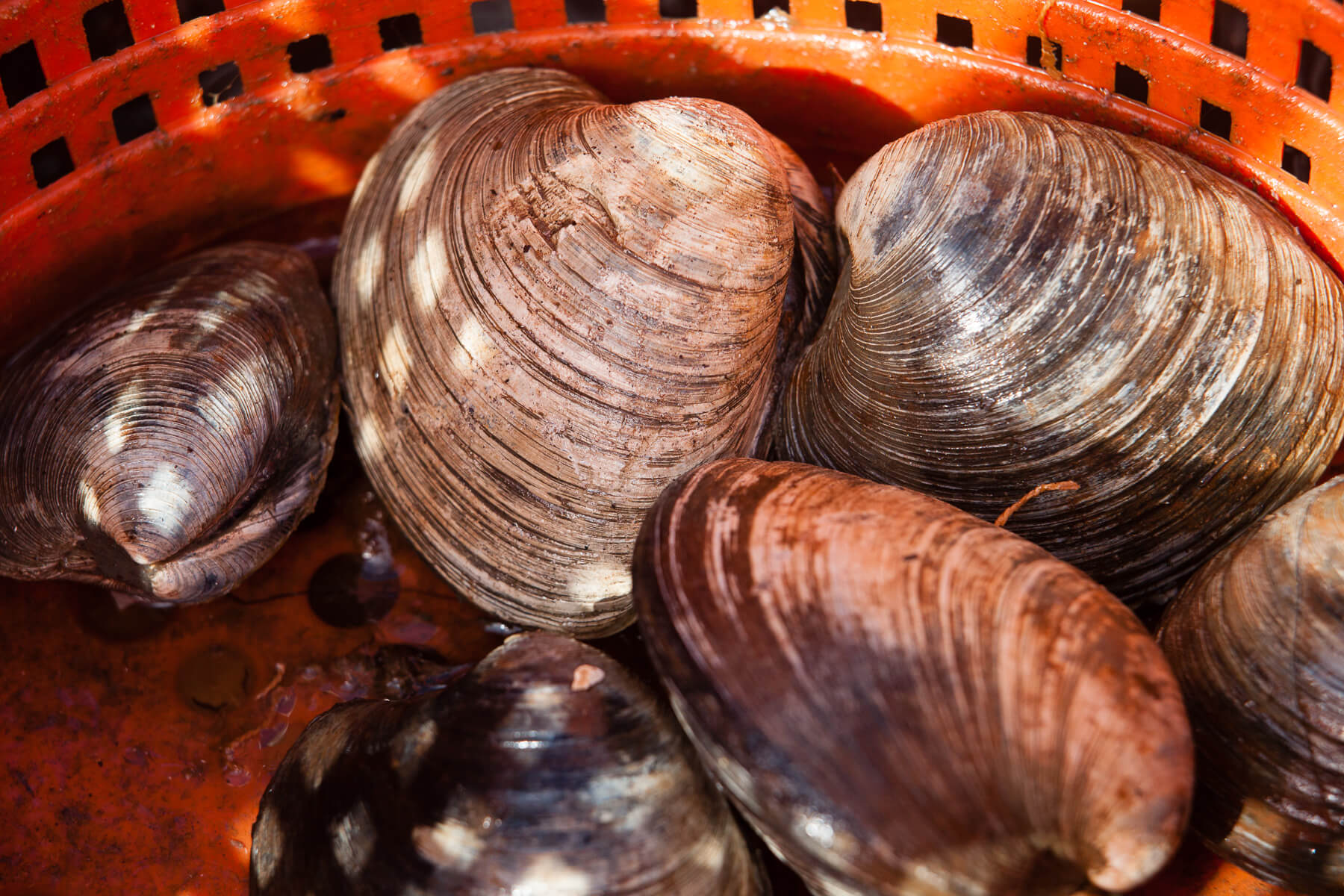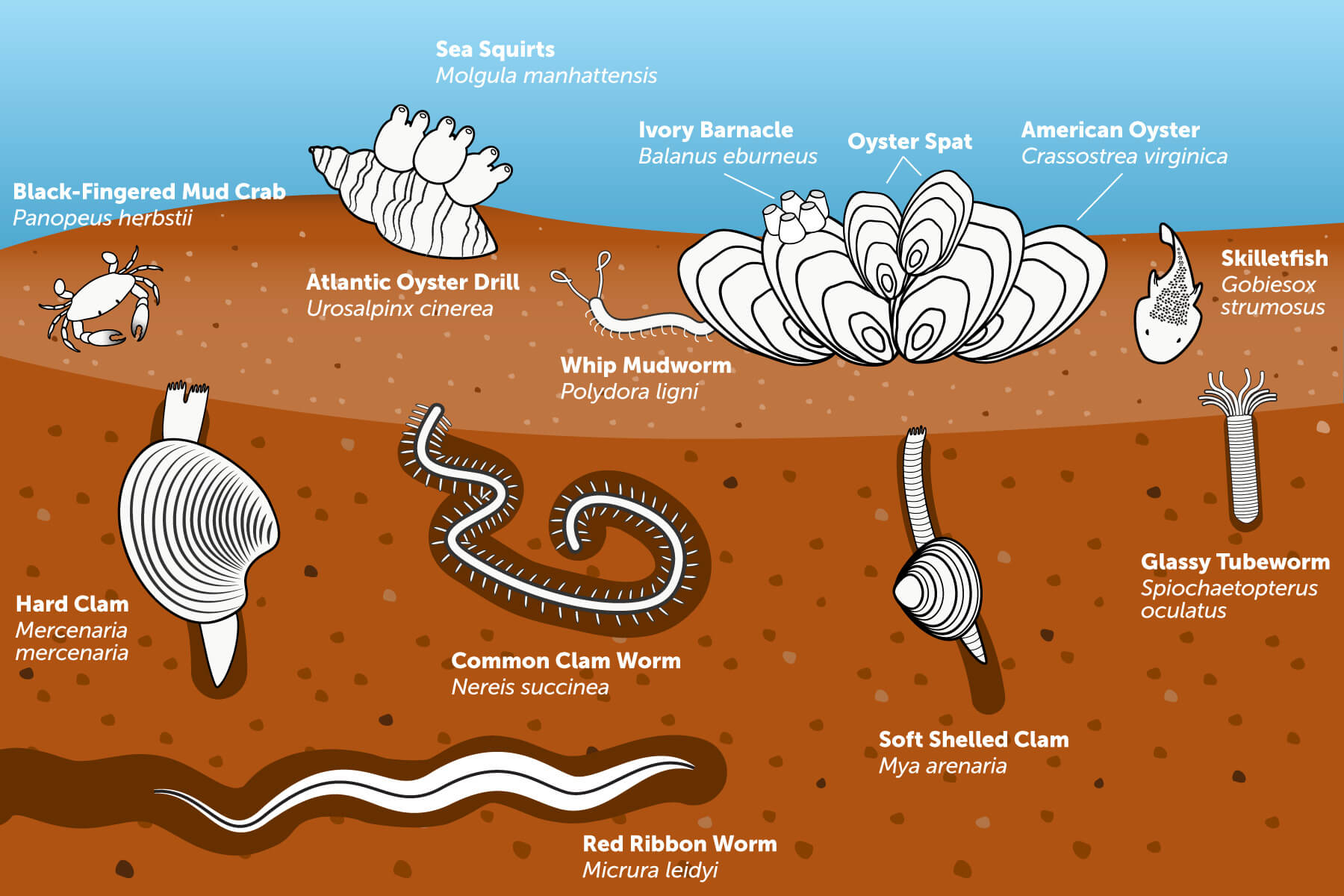What Kind Of Animals Live In The Benthic Zone

Benthos are the organisms that live at the lesser of the Chesapeake Bay and its streams and rivers. The word benthos comes from a Greek term meaning "depths of the sea." Benthic communities are circuitous and include a wide range of animals, plants and bacteria from all levels of the food web. Clams, worms, oysters, shrimp-like crustaceans and mussels are all examples of benthic organisms.
What types of benthic organisms live in the Chesapeake Bay?
There are two groups of benthic organisms, based on their habitat: epifauna and infauna. Epifauna live attached to a surface and infauna live within bottom sediments.
Epifauna
Epifauna live attached to hard surfaces such as rocks, shells and pilings or directly on the surface of the Bay's bottom. Epifauna include oysters, sponges, body of water squirts, bounding main stars and barnacles. An oyster reef is an example of an epifaunal benthic community.
Infauna
Infauna burrow into bottom sediments. Worms, clams and other infauna form their own communities that are connected to the water by tubes and tunnels. A healthy infaunal customs contains many different species.
A typical healthy benthic community

Why are benthic organisms important?
Benthos play several important roles in the food web and serve equally an splendid indicator of environmental conditions in the Bay and its streams and rivers.
An important link in the food web
Benthos link primary producers—phytoplankton—with higher levels in the food web.
- Filter feeders such as clams and oysters consume plankton and organic particles.
- Many benthic creatures, specially clams and worms, serve every bit food for larger, economically important species such every bit blue crabs, striped bass, spot, croaker and white perch.
Additionally, the bacteria, decomposers and detritus-feeders that live at the bottom of the Bay break down waste matter products and dead plants and animals.
An environmental snapshot
Scientists report benthic organisms considering they provide a good snapshot of ecology weather condition in the Bay and its streams and rivers. Nigh benthic creatures cannot motility very far—if at all—so they tin can't avoid pollution or unhealthy h2o conditions.
Benthic communities are exposed to many stressors, including low oxygen levels, excess sediment and chemical contaminants.
- In summer, high temperatures and nutrient pollution often lead to depression-oxygen areas at the bottom of the Bay and its rivers.
- Excess sediment suspended in the water tin block sunlight from reaching bay grasses growing at the bottom. When sediment finally settles, information technology tin bury oyster bars and other benthic species.
- Many chemical contaminants demark to lesser sediments, remaining at that place for years. Benthic species get contaminated when they feed and live in these toxic sediments.
Working with the Maryland Department of Natural Resources and Virginia Department of Ecology Quality, the Chesapeake Bay Plan has monitored the health of benthic organisms in the tidal Chesapeake Bay since 1984. Each yr, researchers with the Chesapeake Bay Benthic Monitoring Programme collect hundreds of samples and compare species affluence, biomass, diverseness and other attributes to weather that would exist expected in a salubrious environs. The sample results are and so scored on a one-to-5 calibration called the Benthic Index of Biotic Integrity, or B-IBI.
Over the by decade, the wellness of lesser habitat in the tidal Bay has remained poor. Researchers did observe small-scale improvements in 2015, however, with 62 percent of the Bay's tidal bottom meeting restoration goals (compared to 59 per centum in 2014). In other words, while 38 per centum of the tidal Bay's bottom habitat is marginal, degraded or severely degraded—habitation to more pollution-tolerant species, fewer species overall, fewer large organisms deep in the sediment and a lower full mass of organisms—well-nigh 2-thirds of this habitat is abode to a healthy community of benthic organisms. Furthermore, the extent of degraded and severely degraded conditions was the lowest information technology has been since 1996. Experts attribute this comeback in lesser habitat to improvements in dissolved oxygen. Improvements in lesser water quality are thought to be the result of low spring river period, which meant lower polluted runoff flowing into the Bay.
Source: https://www.chesapeakebay.net/discover/ecosystem/life_at_the_bottom
Posted by: yudeppoccanot85.blogspot.com

0 Response to "What Kind Of Animals Live In The Benthic Zone"
Post a Comment